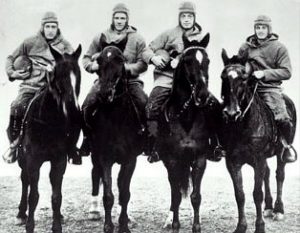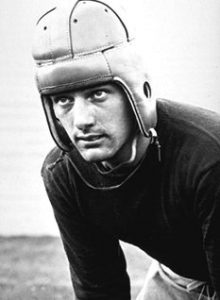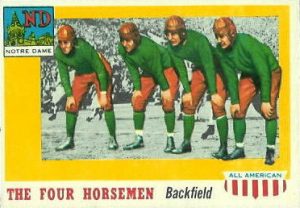Harry August Stuhldreher
October 14, 1901 – January 26, 1965
Massilion, Ohio – Pittsburgh, Pennsylvania

The classic photo of the Horsemen.
Don Miller, Elmer Layden, Jim Crowley, Harry Stuhldreher
“Outlined against a blue, gray October sky the Four Horsemen rode again. In dramatic lore they are known as famine, pestilence, destruction and death. These are only aliases. Their real names are: Stuhldreher, Miller, Crowley and Layden.”
I first made the connection after talking with Mary Louise Stuhldreher, my wife Cathy’s grandmother. She made a comment about taking the train to South Bend to watch her cousin play football. It wasn’t until later that I realized what it really meant!
He became starting quarterback midway through his sophomore year in 1922. He was an All-American that season.
| Notre Dame Quarterback 1922-1924 Jersey Number: 32 Height: 5-7 Weight: 151 High School: Massilion, OHInducted to the College Football Hall of Fame in 1958 |
 |
Harry Stuhldreher Career Statistics
|
The words of Grantland Rice, a sportswriter for the New York Herald-Tribune, that established the name that would aid them in achieving immortality. He derived the name from a halftime conversation that he overheard in the press box of the Notre Dame-Army game on Oct. 18, 1924. George Strickler, a student assistant in the winning team’s sports information office, had been describing a movie that featured biblical features of doom and disaster. Rice thought he would borrow the terms to describe the four men that led to Notre Dame’s 13-7 victory.
These words have become a symbol and legacy to Notre Dame students. Quarterback Harry Stuhldreher, left halfback Jim Crowley, right halfback Don Miller and fullback Elmer Layden destroyed Irish opponents’ defenses with the lineup that Coach Knute Rockne devised for them during their sophomore year in 1922. These four men led Notre Dame to a perfect 10-0 season and the National Championship. Four men known throughout the football world as the most fabled foursome in college history. These four students who brought glory to the Notre Dame Football Stadium.
Strickler later thought he would do anything he could to make sure that the name remained with the four men. After the team arrived back in South Bend from the Army game in New York, he posed the four players in their uniforms, complete with helmets and footballs, on the backs of four horses from a livery stable in town.
After the photo was released onto the wire services, the four men ensured the position as famous football figures of their time.

The words Rice used to describe the men remain today as the most famous lead ever written on a sports event.
Although the Four Horsemen will always be remembered, their team will as well. The 27-10 win over Stanford in the Rose Bowl and Rockne were also vitals facets of the team that has not been forgotten, along with their perfect season.
The four men, however, have a near perfect record themselves. In the 30 games that Stuhldreher, Crowley, Miller and Layden played as a unit, they lost only two, both to Nebraska.
Stuhldreher, an Ohioan, lead the team at quarterback. He could not only utilize his passing ability, but he also returned punts and could throw a block with the best of them. He was cocky, ambitious and feisty, all characteristics that proved to be an asset to leading the team in victory.
At the turning point in one historic Rose Bowl game, Stanford superstar Ernie Nevers was stopped by Notre Dame tackle Harry Stuhldreher at the goal line on a fourth down. For years thereafter, many Californians insisted that Nevers had in fact crossed the goal line and that Notre Dame had stolen a victory. One evening Los Angeles sportswriter George Davis was arguing this very point when a stranger interjected: “I say he didn’t score,” the man declared. “Where were you sitting?” Davis challenged. “I was sitting on Nevers’s neck,” the man replied. “I’m Harry Stuhldreher.”
After graduating, he went on to a brief professional career, one season with the Waterford (Conn.) Blues in the NFL before he joined his teammate Elmer Layden on the roster of the American Football League’s Brooklyn Horsemen. After playing only six games of the 1926 season, the Horsemen merged with the National Football League’s Brooklyn Lions franchise. Stuhldreher turned to college coaching, initially also moonlighting for independent pro teams on weekends. He served for 11 years as head coach at Villanova University starting in 1925, and in 1936 began 13 years as head coach and athletic director at the University of Wisconsin–Madison. Stuhldreher retired from football in 1947 with a combined record of 110-87-15.
In 1950 Stuhldreher joined the U.S. Steel company. He retired in 1960. Harry and his wife, Mary, had four sons.
He was enshrined in the College Football Hall of Fame in 1958. He died in 1965 at the age of 63.
Books and Stories by Harry
Knute Rockne: Man Builder NY: Grosset & Dunlap (1931). This was the book that was adapted for the movie Knute Rockne, All American, which starred Ronald Reagan as George Gipp.
Quarterback Play
Blocking Back, (ss) The American Magazine Sep, Oct, Nov 1936
The Fighting Game, (ms) Thrilling Football #1 1939
Football, a Fighting Game, (ar) Thrilling Sports Jan 1937
The Gravy Game (with W. Thornton Martin), (ss) The Saturday Evening Post Oct 21 1933
Is the Notre Dame Game Slipping-No, (ar) The Saturday Evening Post Oct 6 1934
Off Guard (with W. Thornton Martin), (ss) The Saturday Evening Post Nov 24 1934
STUHLDREHER, MARY
The Tender Touch, (ss) The Saturday Evening Post Nov 13 1954